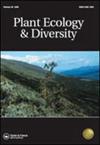巴西东北部大西洋森林遗迹苔藓植物功能特征沿环境梯度的空间分布
IF 1.6
4区 生物学
Q2 PLANT SCIENCES
引用次数: 3
摘要
背景:基于功能性状的方法已被用于识别与环境变异性/变化相关的植物物种多样性和组成模式。苔藓植物受到扰动的影响很快,因此它们的性状和分布有望与环境变异性表现出明确的关系。目的:量化破碎化对大西洋森林遗迹附生苔藓植物多样性和结构的垂直和水平环境梯度的影响。方法:记录6个与水分关系和耐光性相关的功能性状,并选取其中的叶小叶面积进行梯度形态测量分析。比较了不同梯度苔藓植物的功能多样性和组成指标。结果:功能多样性沿垂直和水平梯度变化不大。相反,性状的功能组成发生了显著变化。与水分储存有关的性状,如小叶的存在和面积,以及对过度光入射的保护,如深色色素,在冠层和碎片边缘的数量更多。结论:功能组成与垂直梯度和水平梯度的相关性大于功能多样性。苔类植物的小叶被认为是解释苔藓植物适应策略最相关的性状。本文章由计算机程序翻译,如有差异,请以英文原文为准。
Spatial distribution of functional traits of bryophytes along environmental gradients in an Atlantic Forest remnant in north-eastern Brazil
ABSTRACT Background: Functional trait-based approaches have been used to identify patterns of plant species diversity and composition related to environmental variability/changes. Bryophytes are rapidly affected by perturbations and thus their traits and distribution are expected to show well-defined relationships with environmental variability. Aim: To quantify the impacts of fragmentation on the diversity and structure of epiphytic bryophytes to vertical and horizontal environmental gradients in an Atlantic Forest remnant. Methods: Six functional traits related to water relations and light tolerance were recorded and one of them, the leaf lobule area in liverworts, was selected for morphometric measurements along the gradients analysed. Functional diversity and composition metrics of bryophytes along gradients were compared. Results: Functional diversity changed little along the vertical and horizontal gradients. Conversely, the functional composition of traits changed markedly. Traits related to water storage, such as the presence and area of lobules, and to protection against excess light incidence, such as dark pigments, were more numerous in the canopy and at the fragment edge. Conclusions: Functional composition is more correlated with the vertical and horizontal gradients than functional diversity. The lobule of liverworts stood out as the most relevant trait to explain the adaptive strategies of bryophytes.
求助全文
通过发布文献求助,成功后即可免费获取论文全文。
去求助
来源期刊

Plant Ecology & Diversity
PLANT SCIENCES-
CiteScore
3.30
自引率
0.00%
发文量
26
审稿时长
3 months
期刊介绍:
Plant Ecology and Diversity is an international journal for communicating results and novel ideas in plant science, in print and on-line, six times a year. All areas of plant biology relating to ecology, evolution and diversity are of interest, including those which explicitly deal with today''s highly topical themes, such as biodiversity, conservation and global change. We consider submissions that address fundamental questions which are pertinent to contemporary plant science. Articles concerning extreme environments world-wide are particularly welcome.
Plant Ecology and Diversity considers for publication original research articles, short communications, reviews, and scientific correspondence that explore thought-provoking ideas.
To aid redressing ‘publication bias’ the journal is unique in reporting, in the form of short communications, ‘negative results’ and ‘repeat experiments’ that test ecological theories experimentally, in theoretically flawless and methodologically sound papers. Research reviews and method papers, are also encouraged.
Plant Ecology & Diversity publishes high-quality and topical research that demonstrates solid scholarship. As such, the journal does not publish purely descriptive papers. Submissions are required to focus on research topics that are broad in their scope and thus provide new insights and contribute to theory. The original research should address clear hypotheses that test theory or questions and offer new insights on topics of interest to an international readership.
 求助内容:
求助内容: 应助结果提醒方式:
应助结果提醒方式:


